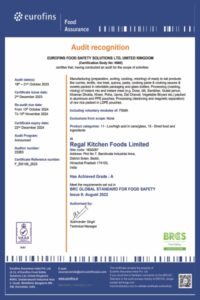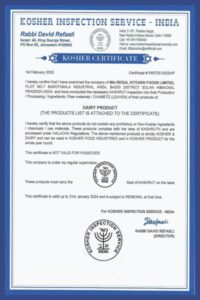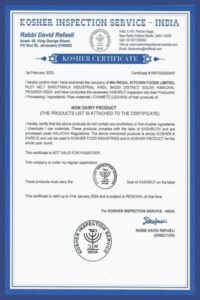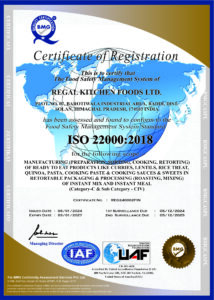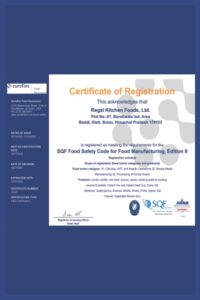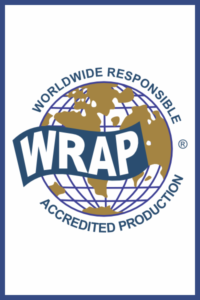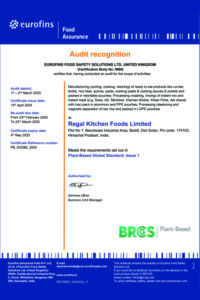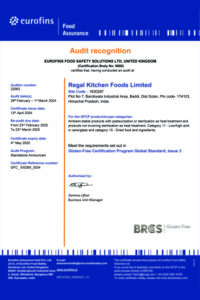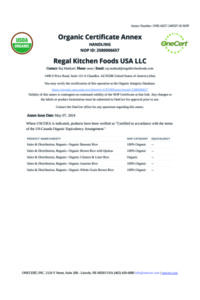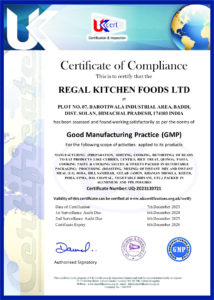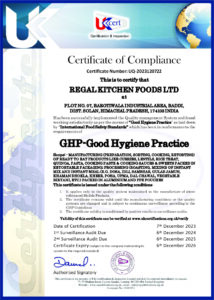





Revamp your cooking experience...
Ready Made Meals
Since 2022, Regal Kitchen Speciality Foods Pvt Ltd has been on a mission to upscale commercial kitchens and HoReCa chains through convenient and ready-to-cook products. We take pride in our ambition to empower chefs across India by speeding up the preparation process with excellent taste, quality, and consistency.
Our recipes drive the delicious flavors of authentic Indian cuisine and help save precious kitchen time for chefs. We promise to make upscaling easy for hotels, restaurants, and QSRs through our ready-to-cook and ready-to-eat prepared meals and simultaneously help chefs retain their specialty dishes with ease.
With the competition growing fast in the HoReCa industry, our products will prove a cost-effective and energy-conserving solution, where you can flexibly add your personal touch of magic, minus the extra effort.
Our Guiding Brands
- Regal Kitchen
- Delhi Kitche
- Desi Swad
- Biryan
- Southpam
 Lorem ipsum dolor sit amet, consectetur adipisicing elit. Optio, neque qui velit. Magni dolorum quidem ipsam eligendi, totam, facilis laudantium cum accusamus ullam voluptatibus commodi numquam, error, est. Ea, consequatur.
Click Here
Lorem ipsum dolor sit amet, consectetur adipisicing elit. Optio, neque qui velit. Magni dolorum quidem ipsam eligendi, totam, facilis laudantium cum accusamus ullam voluptatibus commodi numquam, error, est. Ea, consequatur.
Click Here  Lorem ipsum dolor sit amet, consectetur adipisicing elit. Optio, neque qui velit. Magni dolorum quidem ipsam eligendi, totam, facilis laudantium cum accusamus ullam voluptatibus commodi numquam, error, est. Ea, consequatur.
Lorem ipsum dolor sit amet, consectetur adipisicing elit. Optio, neque qui velit. Magni dolorum quidem ipsam eligendi, totam, facilis laudantium cum accusamus ullam voluptatibus commodi numquam, error, est. Ea, consequatur.  Lorem ipsum dolor sit amet, consectetur adipisicing elit. Optio, neque qui velit. Magni dolorum quidem ipsam eligendi, totam, facilis laudantium cum accusamus ullam voluptatibus commodi numquam, error, est. Ea, consequatur.
Lorem ipsum dolor sit amet, consectetur adipisicing elit. Optio, neque qui velit. Magni dolorum quidem ipsam eligendi, totam, facilis laudantium cum accusamus ullam voluptatibus commodi numquam, error, est. Ea, consequatur.  Lorem ipsum dolor sit amet, consectetur adipisicing elit. Optio, neque qui velit. Magni dolorum quidem ipsam eligendi, totam, facilis laudantium cum accusamus ullam voluptatibus commodi numquam, error, est. Ea, consequatur.
Lorem ipsum dolor sit amet, consectetur adipisicing elit. Optio, neque qui velit. Magni dolorum quidem ipsam eligendi, totam, facilis laudantium cum accusamus ullam voluptatibus commodi numquam, error, est. Ea, consequatur.  Lorem ipsum dolor sit amet, consectetur adipisicing elit. Optio, neque qui velit. Magni dolorum quidem ipsam eligendi, totam, facilis laudantium cum accusamus ullam voluptatibus commodi numquam, error, est. Ea, consequatur.
Lorem ipsum dolor sit amet, consectetur adipisicing elit. Optio, neque qui velit. Magni dolorum quidem ipsam eligendi, totam, facilis laudantium cum accusamus ullam voluptatibus commodi numquam, error, est. Ea, consequatur. Our Guiding Brands
Our Guiding Brands

Eat Regal

Pasta Zing
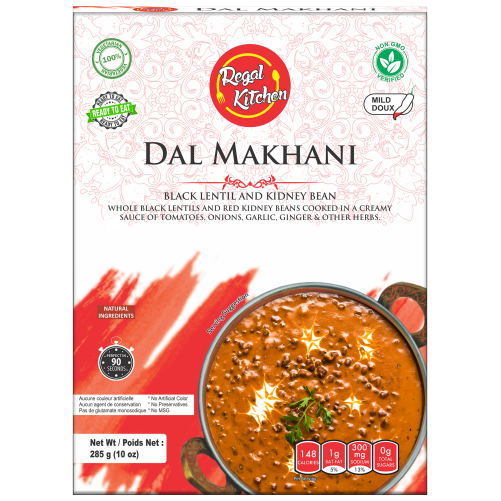
Regal Kitchen
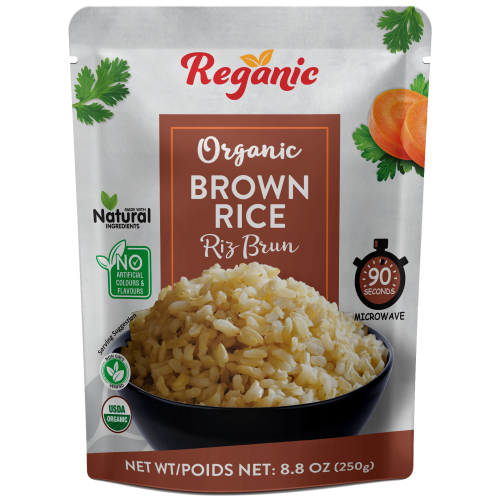
Reganic

Delhi Kitchen
Vission
24 Hrs Access
This is a short description elaborating the service you have mentioned above.
Conference Room
This is a short description elaborating the service you have mentioned above.
High Speed Internet
This is a short description elaborating the service you have mentioned above.
Full Kitchen
This is a short description elaborating the service you have mentioned above.
Wireless Fax & Printer
This is a short description elaborating the service you have mentioned above.
Enrich delicate array of products






"We Are Serving The World"
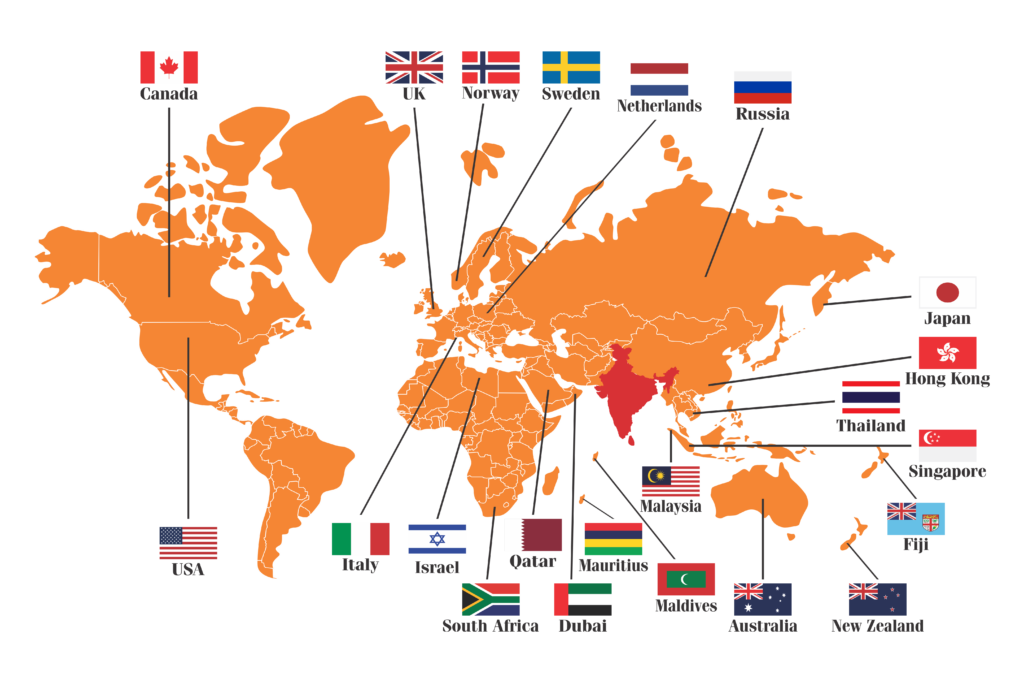
Testimonials
Ready-to-eat food refers to food items that require no additional cooking or preparation before consumption. They are conveniently packaged and can be consumed directly without any cooking or heating. Some examples of ready-to-eat foods are mentioned below:
1. Ready To Eat Indian Curries: Mutter Paneer, Dal Makhani, Rajma Masala, Chana Masala, Aloo Matar, Aloo Methi, Aloo Palak.
2. Ready To Cook Base Gravies: Tomamto Makhani, Rojana Yellow base gravy, Red Kadai Base Gravy
3. Ready To Cook Marinades: Red Tandoori Marinades, Reshmi Tikka Marinades, Haryaali Tikka Marinades, Kali Mirch Tikka Marinades, Lahsooni Tikka Marinades, Malai Tikka Marinades.
4. Ready To Cook Paste & Puree: Tomato Paste, Tomato Puree
5. Ready To Cook Cooking Sauce: Butter Chicken Cooking Sauce
6. Ready To Eat Soya Chaap: Chaap Makhani, Chaap Tikka Masala, Hariyali Chaap.
7. Ready To Eat Combo Meal: Choley Masala With basmati Rice, Dal Makhani With Basmati Rice, Dal tadka With Basmati Rice.
8. Ready To Eat Paratha Combo: Ajwain Paratha With Chaap Tikka Masala, Ajwain Paratha With Mautter Paneer(Tofu), Ajwain Paratha With Palak Paneer (Tofu)
9. Ready To Eat Sweet In Can: Angoori Jamun, Gulab Jamun, Moong Dal Ka Halwa.
10. Cooking Sauce Kits: Kerala Coconut, Korma Sauce, Tikka Masala, Goan Curry
Ready-to-eat food holds significance for several reasons:
1. Convenience: Ready-to-eat food offers convenience to individuals with busy lifestyles or limited access to cooking facilities. It saves time and effort since it requires no additional cooking or preparation, making it a practical choice for those seeking quick and easy meals.
2. On-the-go Consumption: Ready-to-eat food is portable and can be consumed without the need for cooking or reheating. This makes it suitable for people who are traveling, at work, or engaged in activities where traditional meal preparation is not possible.
3. Food Safety: Ready-to-eat foods often undergo processing techniques like pasteurization, canning, or packaging methods that ensure food safety and preservation. These processes help eliminate or minimize harmful bacteria or pathogens, reducing the risk of foodborne illnesses.
4. Variety and Nutrition: Ready-to-eat food options are diverse, offering a wide range of choices for different dietary preferences and requirements. This allows individuals to access balanced meals and essential nutrients conveniently, contributing to their overall nutritional needs.
5. Minimizes Food Waste: Ready-to-eat foods are often portioned and packaged in quantities that can be consumed without leftovers. This helps in minimizing food waste, as only the necessary amount is consumed, reducing the likelihood of unused ingredients or leftovers going to waste.
While ready-to-eat food offers convenience, it's important to maintain a balanced diet by incorporating fresh, unprocessed foods whenever possible. Reading labels, checking nutritional information, and being mindful of portion sizes can help make informed choices within the realm of ready-to-eat options.
The healthiness of pre cooked food depends on the specific product and its ingredients. While there are ready-to-eat options that are healthy and provide essential nutrients, it's important to be cautious as not all ready-to-eat foods are equally nutritious. Here are a few considerations:
1. Nutrient Content: Some ready-to-eat foods, such as fresh fruits and vegetables, yogurt, or packaged salads, can be nutritious and contribute to a healthy diet. They provide essential vitamins, minerals, and fiber. However, other ready-to-eat foods may be high in added sugars, unhealthy fats, sodium, or lacking in key nutrients.
2. Processing and Additives: Ready-to-eat foods often undergo processing, which can involve additives, preservatives, or flavor enhancers. These additives may have negative health effects when consumed in excess. It's important to read labels and choose options with minimal additives or opt for products that prioritize natural ingredients.
3. Portion Sizes: Ready-to-eat foods can come in portion-controlled packages, but it's essential to be mindful of portion sizes. Some products may appear small, but if they are high in calories, unhealthy fats, or added sugars, consuming them in large quantities can still be detrimental to health.
4. Balance and Variety: Relying solely on ready-to-eat foods may lead to an imbalanced diet. It's important to incorporate a variety of foods from different food groups to ensure a well-rounded intake of nutrients. Combining ready-to-eat options with fresh, whole foods like fruits, vegetables, lean proteins, and whole grains is beneficial for overall health.
5. Read Labels and Make Informed Choices: Reading nutrition labels and ingredient lists is crucial when selecting pre cooked foods. Look for products with lower amounts of added sugars, sodium, and unhealthy fats. Consider the overall nutrient profile and choose options that align with your dietary goals and preferences.
In summary, ready-to-eat food can be healthy if you choose wisely, prioritize whole and minimally processed options, and consider their overall nutritional composition. Incorporating a variety of fresh foods alongside ready-to-eat options helps promote a balanced and nutritious diet.
Ready-to-eat (RTE) and ready-to-cook (RTC) are terms used to describe different types of food products:
1. Ready-to-eat (RTE) food: This refers to food that is prepared, cooked, or processed and is ready for consumption without any additional cooking or heating. Ready to eat foods are convenient and can be eaten directly. Examples include packaged salads, sandwiches, fresh fruits, yogurts, and snacks like granola bars.
2. Ready-to-cook (RTC) food: This refers to food products that have been partially prepared or prepped, requiring some additional cooking or preparation before they can be consumed. Ready To Cook foods usually come with instructions on how to cook or prepare them. Examples include marinated meats, pre-cut vegetables, meal kits, or pre-seasoned ingredients that need to be cooked or assembled into a complete meal.
The key distinction between RTE and RTC is that RTE foods are fully prepared and can be consumed without any further cooking, while RTC foods require some level of cooking or preparation before they are ready to be eaten. Both types of products offer convenience to consumers but have different levels of required effort and time for preparation.
Ready-to-eat (RTE) foods are preserved using various techniques to ensure their safety, quality, and shelf life. Some common methods of food preservation for Ready To Eat products include:
Retort technology is a specific preservation method commonly used for packaging RTE foods. Retort packaging involves placing pre-cooked or partially cooked food in a pouch or container and then subjecting it to high heat and pressure in a retort chamber. This process effectively sterilizes the food, eliminating pathogens and extending its shelf life. The combination of heat and pressure in the retort chamber destroys microorganisms, making the food safe for consumption. Retort packaging is commonly used for a variety of RTE products like canned meals, soups, sauces, and ready-to-eat entrees.
The storage duration for ready-to-eat (RTE) food depends on various factors, including the type of food, its ingredients, packaging, and storage conditions. Here are some general guidelines:
1. Fresh RTE Foods: Fresh fruits, vegetables, salads, and other perishable Ready To Eat foods typically have a shorter shelf life and should be consumed within a few days to a week. It's important to check for any signs of spoilage, such as discoloration, off odors, or texture changes, before consuming.
2. Packaged RTE Foods: Pre-packaged RTE foods, such as sandwiches, yogurt cups, or snack bars, often come with expiration dates or "best by" dates printed on their packaging. It's important to adhere to these dates and consume the products before they expire for optimal quality and safety.
3. Canned RTE Foods: Canned RTE foods, like soups, meats, or vegetables, have a longer shelf life due to their sterilized packaging. As long as the cans are undamaged and properly stored, they can typically be stored for months to years, depending on the product. However, it's still recommended to check the expiration dates and follow any storage instructions provided by the manufacturer.
4. Frozen RTE Foods: Frozen RTE foods, including meals, pizzas, or desserts, can be stored for several months in a freezer. The storage duration depends on the specific food item, but it's generally recommended to consume frozen RTE foods within three to six months for best quality.
It's important to note that these are general guidelines, and it's always advisable to read and follow the storage instructions provided on the packaging of the specific RTE food product. Additionally, proper storage conditions, such as maintaining the recommended temperature (refrigerator or freezer), preventing cross-contamination, and avoiding temperature abuse, play a crucial role in preserving the quality and safety of RTE foods. When in doubt, it's best to discard any RTE food that shows signs of spoilage or has exceeded its recommended storage duration.
Our Happy Clients!
No testimonial found

